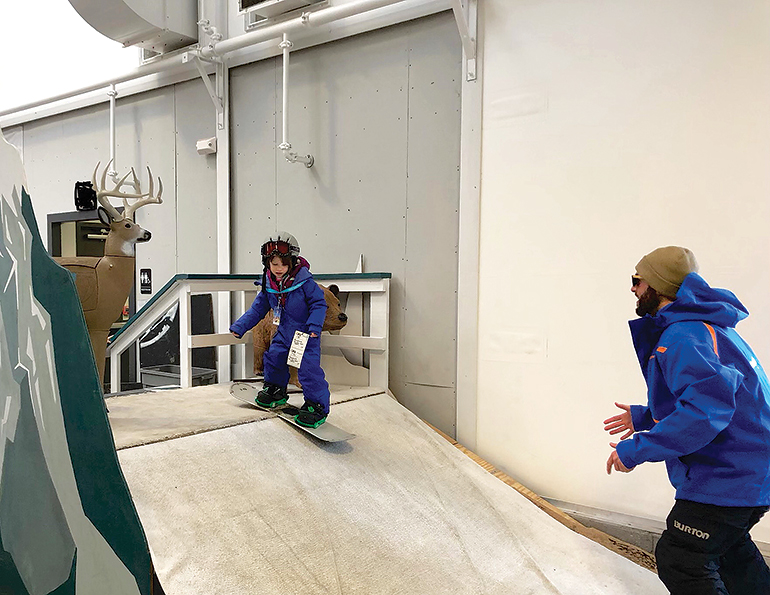The homework: From your own experience, or from what you have witnessed at a resort where you’ve worked, identify a positive example of where a problem was identified and then turned into an opportunity. Discuss in detail what the problem was, and how it was turned into an opportunity. What role did management play? What strategies were used? What was the outcome? How did that change the way you approach problems that you encounter on a day-to-day basis?
Joe: Here at Blue Mountain Resort, our learning center and rental shop are located pretty far from our teaching hill. This posed a problem to our guests, because their first experience in ski boots would be an awkward, challenging, and sometimes painful walk. Occasionally we would have to send a guest all the way back to the rental shop due to a poorly fitting boot, so the guest needed to make the long walk three times before even touching the snow. We knew it was a problem, so we brought all of the managers together for a brainstorming session.
Our first solution was to put instructors in the rental shop to help ensure a proper boot fit. This reduced the amount of back-and-forth between rentals and the teaching hill. However, it was still a long walk to make, even once.
We knew the walk was negatively affecting the first-time lesson experience. Since it was likely the biggest hurdle standing in the way of our overall goal of conversion, we got all of the managers back together to revisit the problem.
The next solution was to purchase two custom-built, 10-passenger trams to transport guests between the rental shop and the learning hill. Our brightest personalities drive the trams, and treat the guests to singing, laughter, and fun snow trivia during the ride. What was once a painful and challenging first impression of the sport evolved into a fun, playful, and uplifting experience.
 Blue Mountain, Pa., turned a problem—the long walk from rental shop to learning hill—into a variety of opportunities that led to improvements. Among them: starting beginners (not just kids, as here) indoors. Starting lessons indoors, a short distance from the rental shop, opened up an even greater opportunity. Now that our instructors were meeting our guests in the rental shop, we realized that we could start grouping and teaching the lessons inside instead of out on the snow at hourly lineups. The instructors could teach the fundamental movements of skiing and riding inside, where it’s warm and quiet. Plus, experienced instructors know to never teach a new skill on new terrain; this new system allowed us to teach these new skills on familiar terrain—dry land—and once they got outside, we could apply these familiar skills to new terrain—on snow.
Blue Mountain, Pa., turned a problem—the long walk from rental shop to learning hill—into a variety of opportunities that led to improvements. Among them: starting beginners (not just kids, as here) indoors. Starting lessons indoors, a short distance from the rental shop, opened up an even greater opportunity. Now that our instructors were meeting our guests in the rental shop, we realized that we could start grouping and teaching the lessons inside instead of out on the snow at hourly lineups. The instructors could teach the fundamental movements of skiing and riding inside, where it’s warm and quiet. Plus, experienced instructors know to never teach a new skill on new terrain; this new system allowed us to teach these new skills on familiar terrain—dry land—and once they got outside, we could apply these familiar skills to new terrain—on snow.
Starting the lesson inside presented another awesome opportunity: lessons on demand. By grouping our lessons inside, we could send out the group as soon as we met our ideal class size. We could vary class size based on guest volume and instructor availability. Our instructors were no longer expected to stand around every hour at lineups and wonder if they would get a lesson, and our guests were no longer expected to wait for the next lineup. It was a win-win situation!
The new system was awesome, but it posed some staffing challenges. We needed to find a way to keep instructors on deck for the next lesson without having them sit around and wait. So we started by putting our on-deck instructors at strategic locations around the resort, to serve as greeters. They help guide our guests through the resort experience, which solved a completely separate issue: lost and confused guests.
Today, our on-deck instructors help in a variety of ways: they shovel snow and spread salt at the entrances, staff the RFID gates, answer questions in the ticket lines, and cover for our lift crew when they need breaks. When on-deck instructors want to freeski, they can take a radio, clock out, and go enjoy the slopes. When we need them, we simply call them in. Instructors that are working toward certifications can go out on clinics, and when we need them to teach, the clinician sends them in.
And finally, the new system allowed us to keep our employees working and on the clock. While some instructors just teach for the love of the sport, others rely on it as a source of income. By creating a system that supports a full day’s work, our young professional staff is able to make steady income. This has resulted in less turnover and greater staff retention.
As for our staff members who don’t rely on the income, they appreciate no longer needing to stand around at lineups, only to find out they don’t have a lesson.
We’re now going into our third year using this system. Sometimes we look back and wonder how we ever did it the old way!
For more on the Summit Series and what’s behind this assignment, see “SAM Summit Series: Problem Solving,” p. 54.
Summit Series adviser Dr. Natalie Ooi’s comments:
This is a fantastic example of how addressing one problem has had a snowball effect and highlighted issues in other areas, which were subsequently addressed. I like Blue Mountain’s “bigger picture” approach—while the initial problem was identified and addressed in isolation, it soon became apparent how interconnected the guest experience, conversion, and employee satisfaction is. By fixing one area, you can have an effect (positive or negative) on another, and therefore a bigger-picture approach is necessary to make sure the whole is improved.
Another thing I like about the conversion of this problem into an opportunity is the focus on employee satisfaction, and the efforts to play to different employee strengths and interests. As I’m sure you are aware, happy employees = happy guests, and that’s not something that can be easily faked.
In the service industry, we talk a lot about “emotional labor”—the effort required of front line employees to put on the “organizational happy face,” even if it is contradictory to employees’ true feelings at any given time. This gets extremely tiring over time, leading to burnout and employee management challenges. By making employees happy, providing them with a variety of options, a full day’s work, etc., you are removing problems that can add to employee turnover.Dr. Ooi directs Colorado State University’s Graduate Ski Area Management Program.






